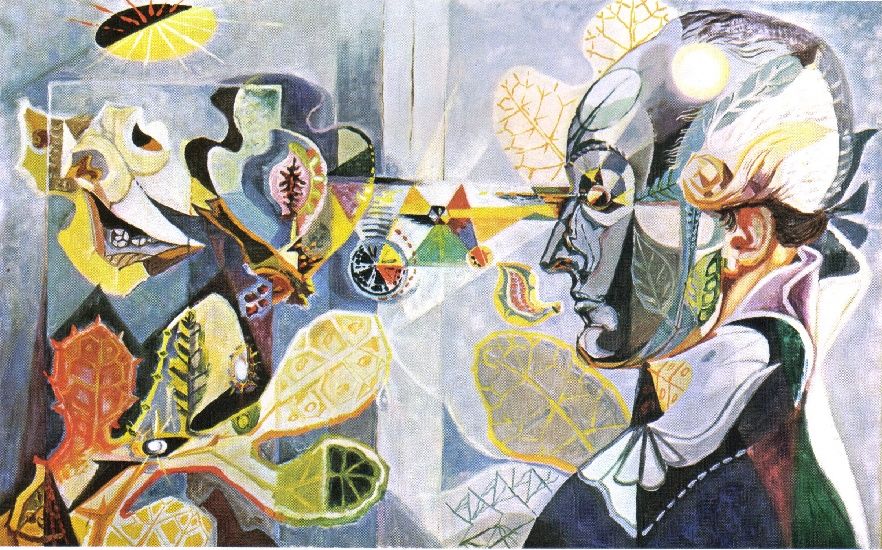Hello!
Do you want a piece of the $623 billion SaaS market forecast this year? Of course, you do — even a percentage of that market share is a tasty bite.
But you probably learned the hard way that marketing a software service differs from marketing a software product. The competition in the SaaS market is bitter, like rhubarb pie without sugar. You’ll have to fight for a slice, which won’t be easy.
SaaS businesses are unique. They have some distinct marketing challenges that product-driven companies don’t face. (Yes, you’re special.) Your business needs SaaS marketing strategies that can scale to reach customers at every stage of their buying journey. B2B content is still the best and most cost-effective way to do this.
What do we want? CONTENT When do we want it? NOW
 Did you know?
Did you know?
- 57% of B2B marketers say content gives them solid leads
- 72% say content promotes audience learning
- 63% say content builds customer loyalty
That’s a lot of bang for the buck on a 500- or 1000-word blog. How can you make sure your content yields this kind of return?
The answer is to build a better SaaS content marketing strategy mousetrap this year.
Build a Better SaaS Content Marketing Strategy for 2025 — and Beyond
- What is it about content for SaaS companies?
- Why do most SaaS content marketing strategies get it wrong (and how to get it right)?
- What is the right way to link the B2B SaaS customer journey to content?
- How to use SEO to focus on the bottom of the sales funnel?
What is it About Content for SaaS Companies?
Content matters. And we’re not talking about the yawn-filled content written by an AI, either. Better B2B SaaS content must be smarter than the average bear. We don’t mean the text or video, either. Instead, we’re talking about linking the content to a measurable, achievable goal as part of a defined SaaS content marketing strategy. It’s the strategy that makes the content intelligent and useful for your SaaS company.
 But not just any SaaS content marketing strategy will get you a piece of the pie this year. You’ll need the kind of strategy that organically grows your business. Organic business growth saves your budget while still harvesting customers. If you’re farming for leads, it’s the most sustainable way to increase your yield.
But not just any SaaS content marketing strategy will get you a piece of the pie this year. You’ll need the kind of strategy that organically grows your business. Organic business growth saves your budget while still harvesting customers. If you’re farming for leads, it’s the most sustainable way to increase your yield.
SaaS companies know this. Content is often their go-to strategy to keep their service top of mind. So, what’s the problem?
Every other SaaS company is trying to do the same thing.
So, you need a better SaaS content marketing strategy than everyone else.
Believe it or not, creating a good SaaS content marketing strategy for your business isn’t rocket science. A good SaaS content marketing strategy is common sense coupled with some analytics.
Here’s what we know.
Why Do Most SaaS Content Marketing Strategies Get It Wrong (and How to Get it Right)?
 The best SaaS content marketing strategies must focus on solving three big problems faced by your industry:
The best SaaS content marketing strategies must focus on solving three big problems faced by your industry:
- Differentiating yourself from competitors.
- Tailoring your content to fit everyone at every stage in the journey.
- Using content to actually convert customers.
With these three challenges in mind, your company must somehow:
Promote your service as the trusted solver of your customer’s unique problems.
- You don’t have to be a thought leader, although that helps with organic growth.
Ultimately, it’s simple: Your target audience has a problem. Your software can solve it.
Your content must reflect the customer’s perspectives on why the hell they should consider you. A dozen other SaaS products are encroaching on the niche you’re trying to carve out.
Why, you? Why, now?
 Promote your service as more than the software.
Promote your service as more than the software.
We’re serious. The chances are astonishingly high that your software has some similar features as your competitors. (Please. Don’t act surprised.) That’s why your SaaS content marketing strategy should focus on how your service does more than that other guy (or gal).
Say you have a 24/7/365 help desk. That’s the service part of your SaaS product. Given how hard it is to get good service today, why aren’t you promoting the A+ service rating your customers give your help desk? (Hello, customer testimonial.)
Do you have 100% up time?
Does your SaaS keep customer data safer?
Does your software deploy faster because it’s more user-friendly?
Maybe you offer ongoing training as part of your initial subscription?
Focusing your content on software features alone runs the risk that you’ll be out-featured in your competitor’s next iteration. What is it about your SaaS business that really sets you apart?
Your goal is to be a trusted advisor to your customers. Trusted advisors solve problems.
 That’s what you should feature in your SaaS content marketing strategy. Trust us.
That’s what you should feature in your SaaS content marketing strategy. Trust us.
Create content that sells without selling.
Most SaaS companies offer free ebooks to capture email leads. This isn’t enough to achieve your SaaS content marketing strategy (What SaaS content marketing strategy?) let alone convert prospects into subscribers. Content looks easy from the outside. (That’s why everyone thinks they can be a writer.) But it’s not. Just look at these numbers:
The average landing page conversion rate for all industries is 2.35%.
The average for B2B companies is 4.31%.
(Yes, we know the conversion rate for free trials and demos is usually much higher.)
 When we’re talking about content and organic growth, we lie to ourselves:
When we’re talking about content and organic growth, we lie to ourselves:
“A 3% conversion rate is great!” “Sure, 90% of the people that hit the landing page left without converting. That’s just because they’re in a different phase of the sales cycle.”
“We have a 4% conversion rate, but that’s okay, because the 96% that didn’t convert weren’t going to be customers, anyway.” “They’ll be back. We’re ‘educating’ them.”
Stop lying to yourself. Good content, defined as targeted, converting, searchable, and above all, organic, is very difficult to come by.
Listen up.
The trick to good content includes:
Linking every part of your SaaS content marketing strategy to a specific conversion goal.
 Measuring every part of your SaaS content marketing strategy.
Measuring every part of your SaaS content marketing strategy.
- Going beyond focusing on top of funnel topics that seek conversion to the content, not the sale itself. (Like thinking you’ve won because the customer downloaded an ebook. Dude, that’s just the beginning.)
- Not assuming that you must educate all potential customers at every stage of the buying journey.
- Having enough patience to allow organic growth to happen.
What is The Right Way to Link the B2B SaaS Customer Journey to Content?
Content can be wiggly. It can have unintended effects on your prospects. Sometimes we focus too much on the forest (our goal is to publish one blog a week) without seeing the trees (why are we publishing that and what is it doing for us?).
 A good SaaS content marketing strategy must avoid content conversions over product conversions. For example, is a landing page or blog aiming to capture an email address with a free ebook better than a freemium subscription or a demo request?
A good SaaS content marketing strategy must avoid content conversions over product conversions. For example, is a landing page or blog aiming to capture an email address with a free ebook better than a freemium subscription or a demo request?
The answer is: Which type of conversion gets you closer to the sale?
The typical SaaS content marketing “strategy” assumes that a company must guide every prospect through all the stages of the customer journey:
Awareness (top of funnel)
Consideration (middle)
Conversion (bottom)
What’s wrong with this?
Unless you’re creating a brand-new SaaS category, you’re probably dealing with prospects who are already in the consideration and conversion part of your funnel.
Explain to us, please, why you wouldn’t focus primarily on converting as your number one strategy and focus?
 It assumes that people who sign up for your content will eventually sign up for your software. The fact that nearly 48% of website visitorsleave a landing page without engaging any deeper with your marketing collateral should tell you how this strategy is just wrong.
It assumes that people who sign up for your content will eventually sign up for your software. The fact that nearly 48% of website visitorsleave a landing page without engaging any deeper with your marketing collateral should tell you how this strategy is just wrong.
When developing a SaaS content marketing strategy, you should focus strictly on content that engages potential customers to the conversion. In SaaS, that could be:
A conversion from a website visitor to a trial customer.
A conversion from a trial into a lead with real potential.
A conversion from a demo to a lead (or customer).
A conversion from a trial to a paying customer.
A conversion from a freemium offering to a paying customer.
Forget that “thought leader” crap. (Okay, it isn’t totally crap, but ignore it right now.) Instead, your SaaS content marketing strategy will maximize ROI in the form of a paying customer.
 That’s the one goal — the one ring to bind them all — and to ensure any money you spend on content will pay you back.
That’s the one goal — the one ring to bind them all — and to ensure any money you spend on content will pay you back.
So, how can you make this happen?
Using SEO to Focus on the Bottom of the Prospect Funnel
The cardinal sin of SaaS content marketing strategy is to focus on generalized copy that hits the awareness stage of your conversion/sales funnel. It’s a waste of time and money.
– Andy Beohar, Managing Partner at SevenAtomsnone
Stop it.
 Create content that solves these problems
Create content that solves these problems
Find keywords that fit
Question: Why focus on this approach for your SaaS content marketing strategy?
Answer: Higher conversions, more money, more sales. Fine. But how do you know what your customer’s pain points are? How do you know what keywords to use? Tips for Figuring Out Where It Hurts (i.e., your customer pain points)
Usually, customer pain points fall into four primary categories: Financial: The customer wants to save money with a SaaS offering.
Process: The customer has an everyday problem they think SaaS may solve.
 Productivity: The customer has technical debt, outdated software, or wants to consolidate from several products down to one (because they’re losing money, their staff is frustrated, or productivity is declining).
Productivity: The customer has technical debt, outdated software, or wants to consolidate from several products down to one (because they’re losing money, their staff is frustrated, or productivity is declining).
Support: The customer service sucks at their old SaaS vendor. Or maybe the product is always down. Basically, they want a better customer experience.
How do you know which of these pain categories attracted your customers to your product? Why don’t ya ask them, silly? Conduct online surveys of current and past customers.
Pay attention to what your customers are saying on social media.
Talk to your sales and customer service team. Watch your competitor’s content.
All these steps will inform a more successful SaaS content marketing strategy. But don’t stop there. You should develop personas from those pain points.
A persona is a hypothetical average set of customers with an assumed demographic, interests, and challenges at the buying stage for your product. The idea is to wrap your head around who you’re selling to.
A persona puts a personality behind the faceless consumers you’re trying to reach. (Keep in mind: If you are targeting business decision-makers you will likely include more than one person in a committee making the decision.)
But there’s another step to creating your SaaS content marketing strategy: SEO.
 How will you turn what you’ve learned into SEO-driven content that simultaneously tackles the pain and ranks higher on Google? This isn’t as hard as it might sound at first.
How will you turn what you’ve learned into SEO-driven content that simultaneously tackles the pain and ranks higher on Google? This isn’t as hard as it might sound at first.
Look at the customer pain points and reverse-engineer what they must experience to get them to this point. Make a list of possible scenarios.
Then, imagine the keywords they would use if they were searching online for SaaS products that alleviate the pain and suffering they’re going through. Think like this:
Best (industry) software (“Best logistics software”)
Top (area) software (“Top customer service software” “Top sales software”)
Best Free (software) (“Best free video conferencing software”
(Competition) alternatives (If they’re trying to leave your competitors, e.g., “Salesforce alternatives” “Microsoft alternatives”)
 The best way to figure this out is to roleplay the client’s Google search. You can play with keyword variations, but what shows up on the search? You will see some suggestions (“People also ask”) for other commonly searched keywords in your Google query. This will also help inform your search.
The best way to figure this out is to roleplay the client’s Google search. You can play with keyword variations, but what shows up on the search? You will see some suggestions (“People also ask”) for other commonly searched keywords in your Google query. This will also help inform your search.
Some keyword variations include:
By software (“tools,” “apps,” “mobile-friendly”)
By business size (“enterprise,” “SMB”)
By current year (“2024” “this year”)
Versus (“vs”)
Pay particular attention to when your competitors pop up. You want to rank above them with a better SaaS content marketing strategy.
Say you have a potential customer looking to solve a specific problem. You would target key phrases such as “improve operations workflows,” “decrease time to hire,” or “increase sales.”
 The type of content you could create includes:
The type of content you could create includes:
How to optimize operations workflows with logistics software?
How to decrease time to hire with an ATS?
How to increase sales with a CRM?
Queries that begin with “how to” often indicate a point of friction or outright pain. The customer doesn’t know how to solve a problem. Look at how helpful you are! You just happen to have the product that can solve the problem.
 Also, note that we’re asking a question that the content ends up answering. Google has this thing about Q&As — if you answer the question well, of course. Google Q&A is a common feature in the google Business Profile listing feature.
Also, note that we’re asking a question that the content ends up answering. Google has this thing about Q&As — if you answer the question well, of course. Google Q&A is a common feature in the google Business Profile listing feature.
If you have an FAQ on your website, you’ll rank higher. Remember the “People also ask” section of a Google query page? That draws from questions on your web page as well as customer queries. You may even make it onto a featured snippet that shows up on a Google search.
So, using questions (and answers) in your SaaS content marketing strategy is just another rung in the content ladder you’re building for consumers to climb
Also read:
- What is Print Marketing and How to use IT in your Marketing Strategy
- The Easiest Way to Remotely Control PC over Internet
- Why You Need to Optimize Your Google Business Profile
Thank you!
Join us on social media!
See you!






